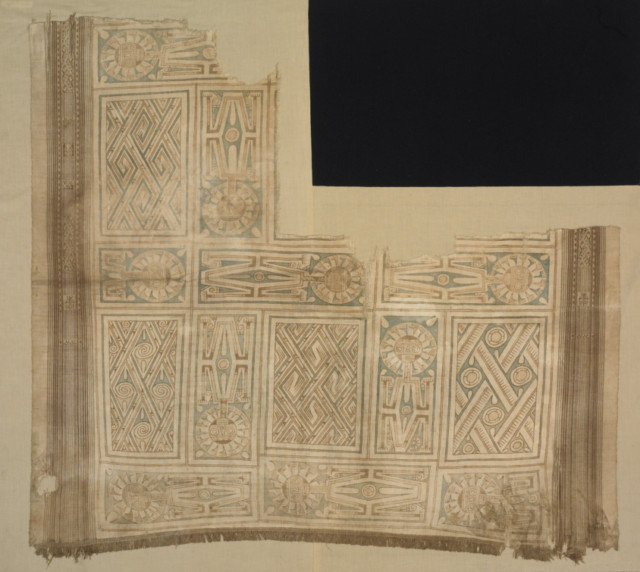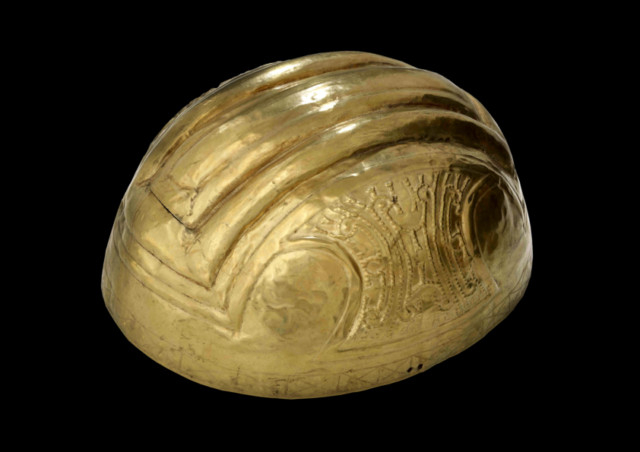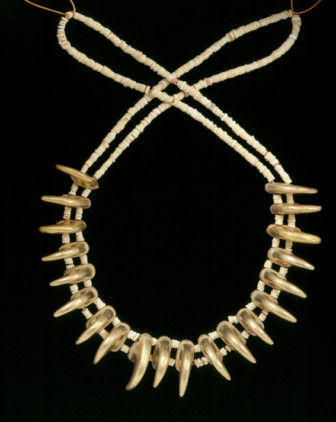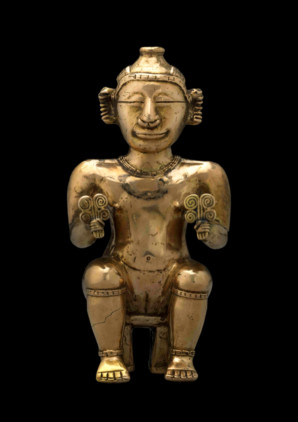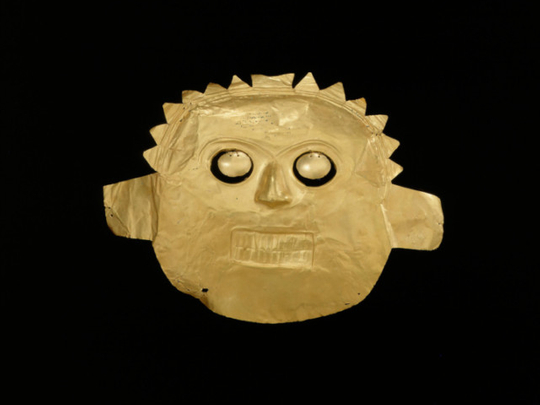
For the Spanish invaders the conquest of Colombia meant only one thing: gold. This was the glittering prize.
True to form, the colonialists, robbed, pillaged, and even shipped in slaves from Africa to excavate the mountains where gold lay hidden. What they found, they melted down and sent back to Spain to shore up their empire. No wonder King Fernando of Aragon ordered in 1513 that the new region to be called Castilla del Oro — Castle of Gold.
Gold was all around them — not just waiting to be dug up but in front of their bedazzled eyes. The tribes of their new colony wore masks, breastplates, earrings and necklaces made of the precious metal; they made intricate models of animals, votive figures and containers designed to hold exotic stimulants. As a friar, one Pedro Simon, wrote in 1627: “There was no Indian or woman who didn’t have … jewels, ear-plates, neck-plates, crowns, lower-lip rings, precious stones.”
A new exhibition at London’s British Museum, “Beyond El Dorado: Power and Gold in Ancient Colombia” examines the marvellous legacy of the indigenous tribes, with 200 objects borrowed from the Museo del Oro in Bogotá and 100 more from the vaults of the British Museum where they lay unseen for years.
It is an inspiring insight into the skills of a people who were working in metal 4,000 years ago and had become pre-eminent in South America by 500BC for their mastery of creating artefacts in gold.
Elisenda Vila Llonch, curator of the exhibition, is keen to stress the “Beyond” of the show’s title. The display opens deliberately with ceramics which illustrate the craftsmanship of six of the peoples involved in the story — the Quimbaya, Calima, Tairona, Tolima, Zenú and Muisca. They make the point that there is more to early Colombian life than gold and throughout there are examples of their work such as feathered headdresses, a rare expanse of cloth used for enrobing a mummified body, and ceramic figures displaying their body painting as well as stone necklaces and sea shell pendants.
If that was the extent of the exhibition it would be fascinating enough but the show takes us beyond the day-to-day life of the tribes people into their belief in the supernatural and — for the higher ranks in the community — an assumption that immortality could be achieved.
But first the myth of “El Dorado” itself, for myth is what it is. It was the Spanish chronicler Fernandez de Oviedo who started it all with his “Historia General y Natural de Las Indias (1535-1548)” in which he wrote about “a golden king” who “went about all covered with powdered gold as casually as if it were powdered salt”.
And a hundred years later in 1636, Bogatá-born Juan Rodriguez Freyle wrote about a ritual on the mountain-top lake of Guatavita, which is about 56 kilometres from the country’s capital.
He described how a tribe leader — in this case, from the Muisca — would be isolated in a cave, banned from the eating of salt and chilli peppers or enjoying the company of women.
Then he was brought to the lake shore, where a raft had been prepared.
Freyle wrote: “They stripped the heir to his skin and anointed him with a sticky earth on which they placed gold dust so that he was completely covered with this metal. They placed him on the raft ... and at his feet they placed a great heap of gold and emeralds for him to offer to his god.”
Once in the middle of the lake the leader and his comrades threw the gold and jewellery into the lake to the sound of trumpets, pipes and flutes from the shores.
By then, in the fevered imagination of the European treasure hunters, the gold-covered figure had become a place, a golden city, and adventurers came flocking.
“There was a desperate search for El Dorado,” Vila Llonch says. “They never found it because it never existed. It started with this distortion of their rituals.”
The Spanish conquistadors drained the lake in 1545 and carried off 6,000 donkey pannier-loads or around 33 tonnes of riches. Tombs were looted through the 18th century and the dream of discovering El Dorado flickered until 1910 when a British company drained the lake again and found ceramic figures of animals, humans and stone beads. No doubt it was to their disappointment that there was no gold but it was to the gain of the British Museum which snapped some of them up in an auction and today have them on display.
“Anything that was in daily use or being worn, the Spanish took and melted down,” Vila Llonch says. “But the gold that had already been buried in tombs or in lakes, they could not get at and so it survived.”
The survival of the relics has helped modern scholars understand how the truth is more striking than the myth and certainly more remarkable than any grubby looter or acquisitive conquistador could have imagined.
It is important to understand that the gold had no use as currency to the tribes. To melt it down into ingots as the Spanish did would have made no sense at all. Nevertheless, the gold was highly valued and traded for its use and for its symbolism, reflecting the divine power of the sun and the people’s beliefs in life, death, and life after death.
Using knowledge based on early Spanish accounts, archaeological research, analogies made with Colombian societies today and a study of the objects themselves, scholars have concluded that gold was a means to power and transformation by wedding supreme craftsmanship with metaphysical beliefs. It was gold that helped them communicate with the gods.
It gave them a system of order that believed in the transformation of the body into other creatures — ones who could see the world differently, cross the boundaries of sky, Earth, water and light, paradise and the lower world.
In a display of artefacts that positively glow from cabinets set in a darkened gallery with sound effects of cicadas and bird song lending an eerie counterpoint, what was fascinating becomes the fabulous. We find the ceremonial body ornaments the tribal leaders wore to create an identity, ensure their supremacy and maintain the balance and wellbeing of their community. The decorations were like a second skin that defined and transformed the individual as he prepared to make a connection with the spirit world. Hammered gold sheets were turned into nose ornaments which jingled as the wearer moved, breastplates with the beak of a bird and the eyes of a man beneath a soaring headdress, a grotesquely grinning half-bat-half-man and helmets too soft for battle but designed to reflect the light and strengthen the wearer with the power of the sun. There are pendants in the shape of “lobster men”, birds and crocodiles. Some of the artefacts are incredibly elaborate, such as the mysterious figures with sticks to their mouths and with what might be masks and wings, taking part in a ritual dance.
Crucial to the communication with the gods were the votive offerings, the tunjos. These were small images which were put in ceramic containers and placed in caves or by rocks and trees, rivers and lakes — anywhere that the gods might hear their appeals for help or receive thanks for a success.
Apparently more than 50 per cent of their work went into making the tunjos. They used bees’ wax to make the shapes, covering them in layers of thin clay. Once the mould was completed it was fired, the wax was melted and poured out to leave a space for the molten gold, which would be poured in to make the final cast. Often the gold would be mixed with copper to create alloys, known as tumbaga, which was easier to cast than gold alone, with different shades and smells. Once cooled, the clay mould was broken and thrown away and the object extracted, which meant that each figure was different.
Sophistication was not required in the making of the tunjos — no time was wasted tidying up the figurines to make them objects of admiration; the important thing was their immediate use in the intercession with the gods.
The details in these figures, which are little more than five to six centimetres high, are arresting. One is holding a bow and arrow in one hand, the decapitated head in the other, acknowledging the importance of headhunting in the time of war. Others show the elite on chairs or benches to symbolise their authority and some carry weapons and sport dramatic head dresses.
One of the most spectacular, and telling, artefacts, the Muisca Raft was found in a cave. It is a tiny gold model showing in intricate detail a new chieftain being rowed across the lake but sadly, it is not in the exhibition. A similar model was destroyed in a fire on board a ship in the 1950s as it was travelling on loan to Germany and the Muisca Raft will never be allowed to take the risk of setting sail from Bogotá.
But there was another, exotic, element in the communication with the spiritual world beyond and this involved the use of hallucinogenic substances.
The best known of these are chicha, a fermented drink, and coca, the leaves of which are still used by Andean peasants to alleviate hunger pangs.
The use of these stimulants was restricted to the leaders of the tribes and by taking them they could embark on what Vila Llonch describes as “mystical soul flights to other dimensions of the Universe to communicate with ancestors and spirits and see and understand the world from another perspective”. More, on their journeys they would meet or “become” other creatures — birds, bats, jaguars, snakes and alligators.
One fantastical figure from the Tairona tribe (AD900-1600) represents a bat-man, teeth-bared ferociously, with gold visor, nose and lip ornaments and a fabulous headdress. By wearing the decoration on his chest — and partaking of the coca — a tribal chief would feel he had been transformed into a bat and be able to find the power to fly at night and prey on victims.
The taking of the enhancing substances required a ritual that involved fasting as well as dancing and music — a golden trumpet from 200BC-AD1300 is on display — and also required the right kind of equipment. To help absorb the coca the leaves were mixed with powdered lime which was stored in containers called poporos. Some were made of gourds but many from sheets of gold, hammered into the shape of flasks, birds or human faces — one from the Calima (200BC-AD1300) sports a nose ring and a green beard.
The most beguiling poporo is that of a seated female from the Quimbaya tribe (500BC–AD700). She is seated, which is a signal of authority and which, says Vila Llonch admiringly, indicates that women did have a say in their society. She has body piercings, a necklace, and marks on the legs which suggest body bindings. She seems to have a half smile which might mean she was mediating.
With the poporos are dippers — long, thin needles, which were put into the containers to withdraw the lime and then mix it with the drugs. Again, as befits the important ritual of consuming the coca, the needle heads were elaborately decorated with miniature figures.
The rituals continue after death — or rather in the life after death. In some societies bodies would be wrapped in a cloth and placed on a stool or tianga. The bodies might be smoked dry or left to decay before being put in a ceramic funerary urn which would be placed in a burial chamber. In this secondary funeral the dead were often surrounded by the possessions that attended their lives or perhaps with decorations specially made for the burial such as the masks from the Calima tribe (1600BC-AD100) with their blank eyes and gaping, expressionless mouth.
As one Spanish observer described a burial vault, “In there they place his weapons and the seats he used to sit on and the cups he used to drink out of and the goblets full of wine and plates full of the delicacies he used to eat and they say they do this so he can eat at night ...”
Most of the works on display were found in the urns because the tribes believed that they should not be hoarded or passed on to another generation but instead stay buried — or handed down to a new set of divine owners.
They have left us with a spectacular testimony to what seems today to be an alien culture but among the golden masks and gorgeous breastplates there are the small details that bring aspects of their daily lives alive: a small ceramic figure from AD600-1600 sits on a stool, a wad of coca bulging in his cheek; there are fish hooks, a pretty frog necklace and earrings decorated with monkeys. Even a pair of tweezers.
Everything that was needed for the mystical soul’s flights to immortality.
Richard Holledge is a writer based in London.
“Beyond El Dorado: Power and Gold in Ancient Colombia” is on at the British Museum in London until March 23, 2014.


